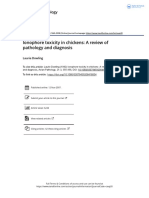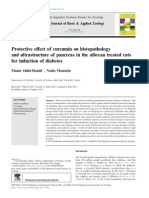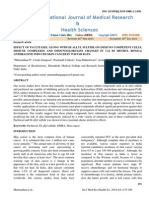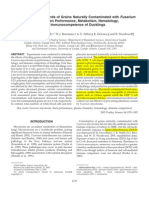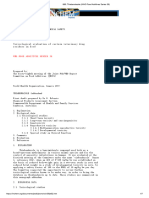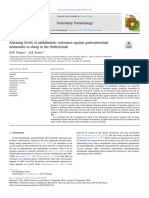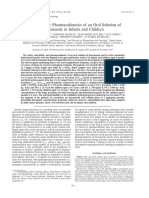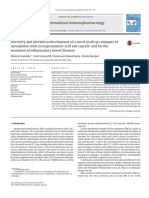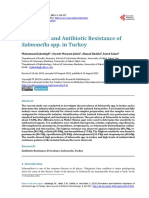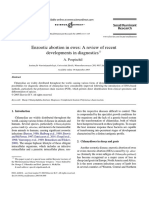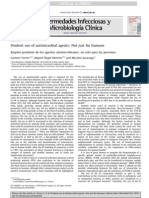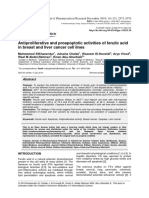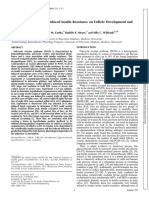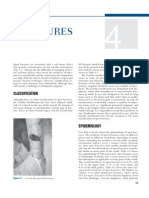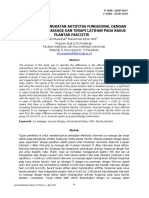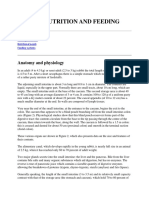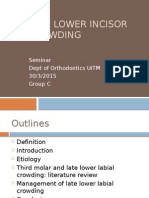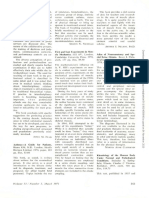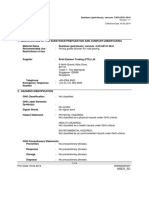Coles Resistance
Coles Resistance
Uploaded by
horpor17Copyright:
Available Formats
Coles Resistance
Coles Resistance
Uploaded by
horpor17Copyright
Available Formats
Share this document
Did you find this document useful?
Is this content inappropriate?
Copyright:
Available Formats
Coles Resistance
Coles Resistance
Uploaded by
horpor17Copyright:
Available Formats
Downloaded from veterinaryrecord.bmj.com on November 27, 2013 - Published by group.bmj.
com
SHORT COMMUNICATIONS
mouths are being examined for the presenc(e of FMD infection. However, where there is a high perce ntage of these lesions, some consideration should be ma de of herbage length, herbage contamination by poachirig, presence of feeding blocks, and stress factors. With no evidence that such factors may be inducing the OMAGOD le sions, then evidence for any possibility of FMD infection sho tuld be followed
up.
Such factors are speculative, but, because2 of constraints upon time and the inability to submit blood samples due to FMD-induced restrictions, it was not possible 1to carry out any other epidemiological investigations, or any diagnostic tests, other than histopathology.
ACKNOWLEDGEMENTS
The SAC carried out the histopathological testtS. MAFF permanent staff in Dumfries sought special permiss,ion for these to be done: the authors' gratitude goes to them for facilitating this.
The efficacy of closantel has already been reported (Coles and others 2000). The present study was undertaken to determine the efficacy of a range of other fasciolicides against adult triclabendazole-resistant fluke. The isolate of F hepatica used in this study originated in County Sligo, Ireland. Fluke eggs collected from treated ewes were used to infect Lymnaea truncatula, and metacercariae from these snails were used to infect two lambs. When the infection was 114 days old the lambs were treated with 10 mg/kg triclabendazole. Eggs from surviving fluke were collected and used to infect further snails. Thus, the present infection was laboratory selected, unlike the previous study (Coles and others 2000) where the isolate came directly from the field. Metacercariae from the selected isolate were used to infect 48 weaned, crossbred lambs which had been reared on a flukefree farm. Approximately 200 metacercariae in a gelatin capsule were administered orally to each lamb. The lambs were grazed outside for five weeks until very wet conditions necessitated they be brought inside. They were given constant access to hay and water and fed a measured concentrate ration each day. Twelve weeks after infection, the lambs were weighed, ranked into groups of six based on weight, and randomly distributed from these groups into six treatment groups. Group 1 was left untreated, group 2 was dosed orally with 7-5 mg/kg albendazole (Valbazen SC 2-5 per cent; Pfizer), group 3 ivermectin (Ivomec Super for cattle; Merial), group 4 was injected subcutaneously with 10 mg/kg nitroxynil (Trodax 34 per cent; Merial), group 5 was given orally 15 mg/kg oxyclozanide together with levamisole (Nilzan Super; ScheringPlough Animal Health) and group 6 triclabendazole in a combination product with levamisole (Combinex; Novartis). Two lambs were removed shortly after treatment due to jaagsiekte disease and one, which showed no sign of infection, was removed postmortem. At the time of infecting the lambs one gelatin capsule had been found on the floor. To stagger the fluke counts, group 1 was humanely euthanased 12 days after the date of treatment, group 6 after 13 days, groups 3 and 4 after 14 days, and groups 2 and 5 15 days after treatment. The numbers of fluke in the livers were counted as described by MAFF ( 1986). Data were compared with the Student's t test (Instat Instant Biostatistics). Triclabendazole plus levamisole (group 6) had no effect on fluke counts, but nitroxynil (group 4) and oxyclozanide (group 5) both showed excellent activity (P<0-001) (Table 1). Albendazole at 7-5 mg/kg (group 2) reduced fluke counts by 94 per cent (P<0-001), but clorsulon (group 3) only caused a 73 per cent reduction in the numbers of fluke (P=0-003). Both nitroxynil (Lucas 1967) and oxyclozanide (Walley 1966) are known to be effective against adult fluke. Since closantel was effective against adult triclabendazole-resistant F hepatica (Coles and others 2000), it was expected that nitroxynil and oxyclozanide would also be effective, as all three may act as uncouplers of adenosine triphosphate formation (Fairweather and Boray 1999). However, cross resistance has been reported between closantel and nitroxynil, but not between closantel and oxyclozanide (Fairweather and Boray 1999). Albendazole at a dose of 7-5 mg/kg removed approximately 95 per cent of adult fluke (Johns and Dickeson 1979) and a similar result was obtained in the present study (94 per cent). Fairweather and Boray (1999) have suggested that triclabendazole acts on tubulin in F hepatica. If this is correct, the change conferring resistance to triclabendazole must be occurring at a different site to that affected by albendazole. Clorsulon is an effective fasciolicide and, although not registered for use in sheep in the UK, treatment of infected sheep at 2 mg/kg killed 99 per cent
723
received
Activity of oxyclozz nitroxynil, clorsule in and albendazole again. adult triclabendaz4 ile resistant Fasciola hepatica
snide
subcutaneous
dose
of 2
mg/kg of clorsulon
with
st
Veterinary Record (2001) 148, 723-724
G. C. Coles, MA, PhD,
CBiol, FIBiol, K. A. Stafford, BSc, LIB,
G. C. COLES, K. A. STAFFORD
IN spite of its long life cycle and the relatively few treatments given each year, the liver fluke, Fasciola hepatic,a, has been able to develop resistance to fasciolicides both inithe laboratory and in the field (Boray 1990, Overend and Bo wen 1995). The resistance to triclabendazole is of immediate concern, as this is the most widely used fasciolicide due to its excellent activity against immature fluke. To enable veterin ary surgeons to advise on therapy of fluke infections, it is imp)ortant to know which fasciolicides will kill the triclabendazole -resistant fluke.
Department of Clinical Veterinary Science, University of Bristol, Langford House, Bristol BS40 5DU
Group
Lambs
1 2 3 4 5 6 7 8 Mean 95 per cent Cl upper 95 per cent ci lower Percentage cure
Control Albendazole Clorsulon Nitroxynil Oxyclozanide
117 144 66 46 93 21 57 _
Triclabendazole
92 115
77-7
117 38
0 0 17 0 1 10 4 _ 4.6 10-6 0 94-1
7 16 26 29 21 25 33 9 20-8 28-6 12.9 73-2
0 0 0 0 0 0 0 0 0 0 100
0 0 0 1 0 1 0
55
22 75
134 104
0-29 0.7 0 99.6
115.8
56-7 0
Cl Confidence interval
The Veterinary Record, June 9, 2001
Downloaded from veterinaryrecord.bmj.com on November 27, 2013 - Published by group.bmj.com
SHORT COMMUNICATIONS
of adult fluke based on postmortem examinations (Rehbein and Visser 1999) or 98 per cent based on faecal egg counts (Corba and others 1996). The efficacy in the present study was lower (74 per cent). However, using faecal egg counts, Moll and others (2000) found a high efficacy of clorsulon against triclabendazole-resistant fluke in cattle, suggesting that there is no cross resistance between triclabendazole and clorsulon. Based on the present data, off-licence use of clorsulon in sheep against triclabendazole-resistant fluke is not recommended. It is currently not known how widespread triclabendazoleresistance has become in the UK. There have only been two reports of failure to control adult fluke in the UK (Mitchell and others 1998 and Thomas and others 2000). However, one reason for the increase in numbers of fluke-infected animals reported by the Scottish Agricultural College (Anon 2000), an observation supported from liver condemnations at a major abattoir in south-west England (K. Smith, personal communication), could be widespread, low-level triclabendazole resistance. Resistance can be detected in young fluke before it is detected in adults (Boray 1990). Reduced efficacy of triclabendazole against immature fluke would result in eggs being passed onto pasture from treated animals before expected, and result in enhanced pasture contamination. Whether this has played a significant role in the increase in cases of fascioliasis is unknown. It could be due to wetter summers, since weather conditions and disease correlate (Ollerenshaw and Rowlands 1959). Since reduced efficacy of triclabendazole against immature fluke is unlikely to be noticed, except in cases of heavy infections, there is a strong case for looking at egg-reappearance periods after treatment of fluke-infected sheep and cattle. The present results show that, if triclabendazole resistance is more widespread than current information suggests, there are three products (closantel, nitroxynil and oxyclozanide) available that can be used with confidence to kill adult triclabendazole-resistant fluke. A fourth product, albendazole, will considerably reduce adult fluke burdens.
sheep in the Netherlands. Veterinary Parasitology 91, 153-158 OLLERENSHAW, C. B. & ROWLANDS, W. T. (1959) A method of forecasting the incidence of fascioliasis in Anglesey. Veterinary Record 71, 591-598 OVEREND, D. J. & BOWEN, F. L. (1995) Resistance of Fasciola hepatica to triclabendazole. Australian Veterinary Journal 72, 275-276 REHBEIN, S. & VISSER, M. (1999) Efficacy of an injectable ivermectin/clorsulon combination against Fasciola hepatica in sheep. Veterinary Record 145, 468 THOMAS, I., COLES, G. C. & DUFFUS, K. (2000) Triclabendazole-resistant fluke in south-west Wales. Veterinary Record 146, 200 WALLEY, J. K. (1966) Oxyclozanide (3,3',5,5',6-pentachloro-2,2'-dihydroxybenzanilide -'Zanil') in the treatment of the liverfluke Fasciola hepatica in sheep and cattle. Veterinary Record 78, 267-276
_ ABSTRACTS
Treatment of superficial squamous cell carcinoma in cats by photodynamic therapy
ELEVEN cats with squamous cell carcinomas, 10 on the nasal planum, two on the ears and one on an eyelid, were treated photodynamically; 5-aminolaevulinic cream was first applied repeatedly to the lesions over four to six hours and they were then exposed for 30 minutes to red light of wavelength 635 nm, supplied by a light-emitting diode placed 1 cm from the lesion. Nine of the 10 lesions on the nose, one of those on the ears and the lesion on the eyelid resolved completely after a single treatment. However, seven of those lesions recurred after between 19 and 56 weeks.
STELL, A. J., DOBSON, J. M. & LANGMACK, K. (2001) Photodynamic therapy of feline superficial squamous cell carcinoma using 5-aminolaevulinic acid. Journal of Small Animal Practice 42, 164-169
ACKNOWLEDGEMENTS
The authors are grateful to E. G. Graham for the production of metacercariae and to Schering-Plough and Merial for financial support.
References
ANON (2000) Fascioliasis widely reported in Scotland. Veterinary Record 146, 332-334 BORAY, J. C. (1990) Drug resistance in Fasciola hepatica. In Resistance of Parasites to Antiparasitic Drugs. Eds J. C. Boray, P. J. Martin, R. T. Roush. Rahway, MSD AGVET. pp 51-60 COLES, G. C., RHODES, A. R. & STAFFORD, K. A. (2000) The activity of closantel against triclabendazole-resistant Fasciola hepatica. Veterinary Record 146,504 CORBA, J., VARADY, M., PRASLICKA, J. & TOMASOVICA, 0. (1996) Efficacy of INOMEC-F against naturally acquired gastrointestinal worms, lungworms (Dictyocaulus filaria) and liver flukes (Fasciola hepatica) in sheep. Helminthologia 33, 133-135 FAIRWEATHER, I. & BORAY, J. P. (1999) Fasciolicides: efficacy, actions resistance and its management. Veterinary Journal 158, 81-112 JOHNS, D. R. & DICKESON, S. J. (1979) Efficacy of albendazole against Fasciola hepatica in sheep. Australian Veterinary Journal 55,431-432 LUCAS, J. M. S. (1967) 4-Cyano-2-iodo-nitrophenol, M&B 210,755. British VeterinaryJournal 123,198-211 MAFF (1986) Manual of Veterinary Parasitological Laboratory Techniques. London, HMSO MITCHELL, G. B. B., MARIS, L. & BONNIWELL, M. A. (1998) Triclabendazole-resistant fluke in Scottish sheep. Veterinary Record 143, 399 MOLL, L., GAASENBEEK, C. P. H., VELLEMA, P. & BORGSTEEDE, F. H. M. (2000) Resistance of Fasciola hepatica against triclabendazole in cattle and
Osteoarthritis as a systemic disorder
IN osteoarthritis substantial changes are increasingly recognised in many tissues, and not all are localised to the affected joints. There is also a well established link with obesity. The mesenchymal cells that maintain these tissues have a common origin. This paper proposes the hypothesis that primary generalised osteoarthritis is a metabolic disorder in which systemic factors induce changes in skeletal tissues by modification of the formation and biosynthetic activity of cells derived from mesenchymal precursors. If proven, this hypothesis could have important implications for new approaches to pharmacological intervention in early stages of the disease process.
ASPDEN, R. M., SCHEVEN, B. A. A. & HUTCHINSON, J. D. (2001) Osteoarthritis as a systemic disorder. Lancet 357, 1118
724
The Veterinary Record, June 9, 2001
Downloaded from veterinaryrecord.bmj.com on November 27, 2013 - Published by group.bmj.com
Activity of oxyclozzanide, nitroxynil, clorsulon and albendazole against adult triclabendazole resistant Fasciola hepatica
G. C. Coles and K. A. Stafford Veterinary Record 2001 148: 723-724
doi: 10.1136/vr.148.23.723
Updated information and services can be found at:
http://veterinaryrecord.bmj.com/content/148/23/723.citation
These include:
References Email alerting service
Article cited in:
http://veterinaryrecord.bmj.com/content/148/23/723.citation#related-urls
Receive free email alerts when new articles cite this article. Sign up in the box at the top right corner of the online article.
Notes
To request permissions go to:
http://group.bmj.com/group/rights-licensing/permissions
To order reprints go to:
http://journals.bmj.com/cgi/reprintform
To subscribe to BMJ go to:
http://group.bmj.com/subscribe/
You might also like
- Health Visiting Student and New Starter Induction PackDocument14 pagesHealth Visiting Student and New Starter Induction Packrjt903100% (1)
- Studyguide 15Document254 pagesStudyguide 15Jacob Dougherty100% (1)
- Alpaca With Gastrointestinal ParasitesDocument6 pagesAlpaca With Gastrointestinal ParasitesMai Chi PhạmNo ratings yet
- Cat HerniasDocument4 pagesCat HerniasbogdanotiNo ratings yet
- A Major Locus Confers Triclabendazole Resistance in Fasciola Hepatica and Shows Dominant InheritanceDocument29 pagesA Major Locus Confers Triclabendazole Resistance in Fasciola Hepatica and Shows Dominant InheritanceANDRES FELIPE POLANIA PIÑANo ratings yet
- Ionophore ToxicityDocument15 pagesIonophore ToxicityKamini AnamaleiNo ratings yet
- Evaluación de Campo de Dos Fasciolicidas en Bovinos Rubia Gallega.Document62 pagesEvaluación de Campo de Dos Fasciolicidas en Bovinos Rubia Gallega.Raul alejandro Kim gomezNo ratings yet
- TMP A980Document12 pagesTMP A980FrontiersNo ratings yet
- Coles - World Association For The Advancement of Veterinary ParasitologyDocument11 pagesColes - World Association For The Advancement of Veterinary ParasitologyAlvaro Iván Niño UribeNo ratings yet
- Parasite Control in Pasture-Grazed Dairy Cattle: Are We at The Edge of A Precipice?Document7 pagesParasite Control in Pasture-Grazed Dairy Cattle: Are We at The Edge of A Precipice?Oktrestu Dwi PutraNo ratings yet
- Protective Effect of Curcumin On Histopathology and Ultrastructure of Pancreas in The Alloxan Treated Rats For Induction of DiabetesDocument11 pagesProtective Effect of Curcumin On Histopathology and Ultrastructure of Pancreas in The Alloxan Treated Rats For Induction of DiabetesJhoel Zuñiga LunaNo ratings yet
- A Comparison of Fluoroquinolones Versus Other Antibiotics For Treating Enteric Fever Meta-AnalysisDocument11 pagesA Comparison of Fluoroquinolones Versus Other Antibiotics For Treating Enteric Fever Meta-AnalysisNurul FitriyahNo ratings yet
- AMR Profiles of Common Mastitis Pathogens On Canadian Dairy FarmsDocument14 pagesAMR Profiles of Common Mastitis Pathogens On Canadian Dairy FarmsApril LarasatiNo ratings yet
- World Association For The Advancement of Veterinary Parasitology (W.A.A.V.P.) Methods For The Detection of Anthelmintic Resistance in Nematodes of Veterinary ImportanceDocument10 pagesWorld Association For The Advancement of Veterinary Parasitology (W.A.A.V.P.) Methods For The Detection of Anthelmintic Resistance in Nematodes of Veterinary ImportanceBrenda GonzalesNo ratings yet
- (17417899 - Reproduction) Letrozole Vs Estradiol Valerate Induced PCOS in Rats - Glycemic, Oxidative and Inflammatory Status AssessmentDocument9 pages(17417899 - Reproduction) Letrozole Vs Estradiol Valerate Induced PCOS in Rats - Glycemic, Oxidative and Inflammatory Status AssessmentShaimaa NasrNo ratings yet
- 2 Edvol 2 P 2 DDocument152 pages2 Edvol 2 P 2 DJin SiclonNo ratings yet
- Wolstenholme 2005Document11 pagesWolstenholme 2005diijah678No ratings yet
- Human Loiasis in A Cameroonian Village A Double-Blind, Placebo-Controlled, Crossover Clinical Trial of Athree-Day Albendazole RegimenDocument5 pagesHuman Loiasis in A Cameroonian Village A Double-Blind, Placebo-Controlled, Crossover Clinical Trial of Athree-Day Albendazole RegimenLucchéri Ndong AkomezogheNo ratings yet
- Semiquantitative Assessment of The Distribution of Salmonella in The Environment of Caged Layer FlocksDocument10 pagesSemiquantitative Assessment of The Distribution of Salmonella in The Environment of Caged Layer Flocksnathasia_ronauliNo ratings yet
- Evaluation of Tests For Anthelmintic Resistance in CyathostomesDocument13 pagesEvaluation of Tests For Anthelmintic Resistance in CyathostomesBrenda GonzalesNo ratings yet
- 30 Muninathan EtalDocument6 pages30 Muninathan EtaleditorijmrhsNo ratings yet
- Juvenile Mortality in Captive Lesser Kudu (Tragelaphus Imberbis) at Basle Zoo and Is Relation To Nutrition and HusbandryDocument7 pagesJuvenile Mortality in Captive Lesser Kudu (Tragelaphus Imberbis) at Basle Zoo and Is Relation To Nutrition and Husbandrydra.ozonioNo ratings yet
- Ball 1990Document15 pagesBall 1990dusakeNo ratings yet
- Trabajo MichiganDocument10 pagesTrabajo MichiganJuan Martín VargasNo ratings yet
- Chowdhury Et Al 2005aDocument7 pagesChowdhury Et Al 2005acontramondum1232039No ratings yet
- Emea 1Document3 pagesEmea 1amin138irNo ratings yet
- Peer Reviewed: An Irish Perspective On CryptosporidiumDocument6 pagesPeer Reviewed: An Irish Perspective On CryptosporidiumDrivailaNo ratings yet
- Journal of Veterinary Medicine Series A - 2003 - Herradora - Effect of Oral Enrofloxacin and Florfenicol on Pigs (1)Document5 pagesJournal of Veterinary Medicine Series A - 2003 - Herradora - Effect of Oral Enrofloxacin and Florfenicol on Pigs (1)emmanouelaapostolopoulouNo ratings yet
- Thiabendazole (WHO Food Additives Series 39)Document7 pagesThiabendazole (WHO Food Additives Series 39)hellen86150No ratings yet
- Veterinary Parasitology: Research PaperDocument5 pagesVeterinary Parasitology: Research PaperDr-Sadaqat Ali RaoNo ratings yet
- Antiparasitic Activity of An Ivermectin and PraziqDocument16 pagesAntiparasitic Activity of An Ivermectin and PraziqPablo OrricoNo ratings yet
- Kaeoket 2006Document5 pagesKaeoket 2006Sofines MurhavisaNo ratings yet
- Funit Copii 6 Luni - 12 AniDocument5 pagesFunit Copii 6 Luni - 12 AniLyova OrashanNo ratings yet
- 891-894 DR SepehriDocument4 pages891-894 DR Sepehrimahardikathesa_21490No ratings yet
- EchinococcusDocument20 pagesEchinococcusJuan Fernando Calcina IsiqueNo ratings yet
- Antibody Titres Against Canine Distemper Virus inDocument6 pagesAntibody Titres Against Canine Distemper Virus inEduardo SantamaríaNo ratings yet
- Tartrazine Yellow: SynonymsDocument11 pagesTartrazine Yellow: Synonymsbestread67No ratings yet
- Fibroblast Mitogens in Bronchoalveolar Lavage (Bal) Fluid From Asbestos-Exposed Subjects With and Without Clinical Evidence of Asbestosis: No Evidence For The Role of PDGF, TNF-á, IGF-1, OR IL-1âDocument5 pagesFibroblast Mitogens in Bronchoalveolar Lavage (Bal) Fluid From Asbestos-Exposed Subjects With and Without Clinical Evidence of Asbestosis: No Evidence For The Role of PDGF, TNF-á, IGF-1, OR IL-1âTRACERBULLET006No ratings yet
- 1-s2.0-S0304401707006632-mainDocument10 pages1-s2.0-S0304401707006632-mainmfuentesNo ratings yet
- Clinicopathological Features of Equine Primary Hepatic Disease A Review of 50 CasesDocument6 pagesClinicopathological Features of Equine Primary Hepatic Disease A Review of 50 CasesGrasiene MenesesNo ratings yet
- Latest PaperDocument9 pagesLatest PapersunilNo ratings yet
- Investigation of Effects of Antibiotics in Poultry and Farm Animals Review-1Document7 pagesInvestigation of Effects of Antibiotics in Poultry and Farm Animals Review-1hospitalpharmacist23No ratings yet
- Saudi Pharmaceutical Journal: Evaluation of Teratogenicity and Genotoxicity Induced by Kramecyne (KACY)Document10 pagesSaudi Pharmaceutical Journal: Evaluation of Teratogenicity and Genotoxicity Induced by Kramecyne (KACY)fathullahdhyaNo ratings yet
- 76 Vol9Document4 pages76 Vol9Acing GucingduaNo ratings yet
- Prevalence and Antibiotic Resistance Of: Salmonella Spp. in TurkeyDocument5 pagesPrevalence and Antibiotic Resistance Of: Salmonella Spp. in TurkeyElang SudewaNo ratings yet
- O-073 Seroprevalence of Enzootic Abortion and Toxoplasmosis in Sheep Flocks Experiencing Reproductive LossesDocument2 pagesO-073 Seroprevalence of Enzootic Abortion and Toxoplasmosis in Sheep Flocks Experiencing Reproductive LossesAbidas ArbNo ratings yet
- Enzootic Abortion in Ewes: A Review of Recent Developments in DiagnosticsDocument3 pagesEnzootic Abortion in Ewes: A Review of Recent Developments in DiagnosticsErnesto VersailleNo ratings yet
- Prudent Use of Antimicrobial Agents: Not Just For HumansDocument3 pagesPrudent Use of Antimicrobial Agents: Not Just For HumansJosé Luis Navarro RomeroNo ratings yet
- Ent Rise Ad C: S. Andrews, T N. J. K. Hole,? E. A. Munn$ Andi T. P. RolphifiDocument8 pagesEnt Rise Ad C: S. Andrews, T N. J. K. Hole,? E. A. Munn$ Andi T. P. RolphifiAngéllica MaríaNo ratings yet
- Influence of Subtherapeutic Levels of Oxytetacycline On Salmonella Typhimurim in Swine, Calves, and ChickensDocument9 pagesInfluence of Subtherapeutic Levels of Oxytetacycline On Salmonella Typhimurim in Swine, Calves, and ChickensLa Fille D'ÈveNo ratings yet
- 802 1351 2 PBDocument4 pages802 1351 2 PBdrjawadzafarchNo ratings yet
- Embryotoxic and Teratogenic Effects of TartrazineDocument7 pagesEmbryotoxic and Teratogenic Effects of TartrazineFlorynu FlorinNo ratings yet
- Feluric Acid As A AnticancerDocument6 pagesFeluric Acid As A AnticancerrinjaniNo ratings yet
- EN - Analyse Rattenstudie Séralini Et AlDocument11 pagesEN - Analyse Rattenstudie Séralini Et AluncleadolphNo ratings yet
- Pharmacokinetics and Bioavailability of Florfenicol Following Intravenous, Intramuscular and Oral Administrations in RabbitsDocument10 pagesPharmacokinetics and Bioavailability of Florfenicol Following Intravenous, Intramuscular and Oral Administrations in RabbitsJohanna Valentina López CortesNo ratings yet
- Effect of Glucocorticoid-Induced Insulin Resistance On Follicle Development and OvulationDocument12 pagesEffect of Glucocorticoid-Induced Insulin Resistance On Follicle Development and Ovulationece142No ratings yet
- Zhao 2017Document22 pagesZhao 2017Adrien Kyle JacintoNo ratings yet
- Complementary and Alternative Medical Lab Testing Part 2: RespiratoryFrom EverandComplementary and Alternative Medical Lab Testing Part 2: RespiratoryNo ratings yet
- Open Fracture - GustiloDocument9 pagesOpen Fracture - GustiloWan Hafiz W YusoffNo ratings yet
- Navy Corpsman Sick Call Screeners GuideDocument215 pagesNavy Corpsman Sick Call Screeners GuidejustanothergunnutNo ratings yet
- Nature of LearningDocument2 pagesNature of LearningFlorens Genoves BagatNo ratings yet
- Siare Perseo - Service ManualDocument55 pagesSiare Perseo - Service Manualanto-siem100% (2)
- Vasudevan 2010Document6 pagesVasudevan 2010Nurul Huda KowitaNo ratings yet
- Participating With Safety UnitDocument16 pagesParticipating With Safety Unitapi-320922686No ratings yet
- 3 ResearchassessmentDocument2 pages3 Researchassessmentapi-352157546No ratings yet
- Efektivitas Peningkatan Aktifitas Fungsional Dengan Intervensi Ice Massage Dan Terapi Latihan Pada Kasus Plantar FasciitisDocument8 pagesEfektivitas Peningkatan Aktifitas Fungsional Dengan Intervensi Ice Massage Dan Terapi Latihan Pada Kasus Plantar FasciitisTiara PutriNo ratings yet
- McKeown 2016 Determinants of Health (Ch9 Brown & Closser Understanding & Applying Medical Anthropology) )Document10 pagesMcKeown 2016 Determinants of Health (Ch9 Brown & Closser Understanding & Applying Medical Anthropology) )Jesse StockerNo ratings yet
- PhilHealth Circular No. 0035, s.2013 Annex 10 List of Alternative Documents For Record of Operative or Surgical TechniqueDocument14 pagesPhilHealth Circular No. 0035, s.2013 Annex 10 List of Alternative Documents For Record of Operative or Surgical TechniqueChrysanthus HerreraNo ratings yet
- Chapter 2Document64 pagesChapter 2elbannanNo ratings yet
- Case - NimhansDocument5 pagesCase - NimhansRajashree Praveen100% (1)
- Gunn-Moore Virbagen Omega EnglishDocument7 pagesGunn-Moore Virbagen Omega EnglishAlexandra MihaiNo ratings yet
- CII Water Technology PPT Rreview 0Document21 pagesCII Water Technology PPT Rreview 0AmodNo ratings yet
- Growth and Yield Performance of Radish (Raphanus Sativus L.) 'CV' 'SNOW WHITE' in Response To Varying Levels of Vermicast ApplicationsDocument5 pagesGrowth and Yield Performance of Radish (Raphanus Sativus L.) 'CV' 'SNOW WHITE' in Response To Varying Levels of Vermicast ApplicationsJASH MATHEWNo ratings yet
- Dairy FarmingDocument2 pagesDairy Farmingjraj030_2k6No ratings yet
- Chapter 1Document11 pagesChapter 1talaaghaNo ratings yet
- Beauty Tips Guide PDFDocument16 pagesBeauty Tips Guide PDFKusumaNo ratings yet
- Concept Map RSVDocument9 pagesConcept Map RSVapi-546522783No ratings yet
- Talley & O'Connor Quiz SampleDocument5 pagesTalley & O'Connor Quiz SamplefilchibuffNo ratings yet
- Cosmetic Clay ClassDocument14 pagesCosmetic Clay ClassVeronica Lacerda100% (5)
- Late Lower Incisor CrowdingDocument18 pagesLate Lower Incisor CrowdingHaffie HafiziNo ratings yet
- Volume 51 / Number 3, March 1971Document2 pagesVolume 51 / Number 3, March 1971Anaz Abdul HakeemNo ratings yet
- Exam Health Ethics Midterm With AnswerDocument4 pagesExam Health Ethics Midterm With AnswerMICHAEL M. ISIDRO100% (3)
- Nejmoa 003289Document7 pagesNejmoa 003289Mirela CiobanescuNo ratings yet
- Burns RehabDocument4 pagesBurns RehabNujella BalajiNo ratings yet
- SGH Rotator Cuff Tendinopathy PDFDocument7 pagesSGH Rotator Cuff Tendinopathy PDFRichard Cortez0% (1)
- Safety Data Sheet: Residues (Petroleum), Vacuum. CAS 64741-56-6Document14 pagesSafety Data Sheet: Residues (Petroleum), Vacuum. CAS 64741-56-6Abrar HussainNo ratings yet





